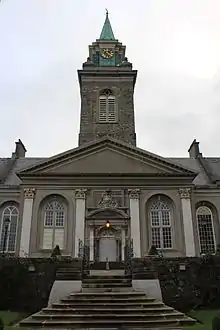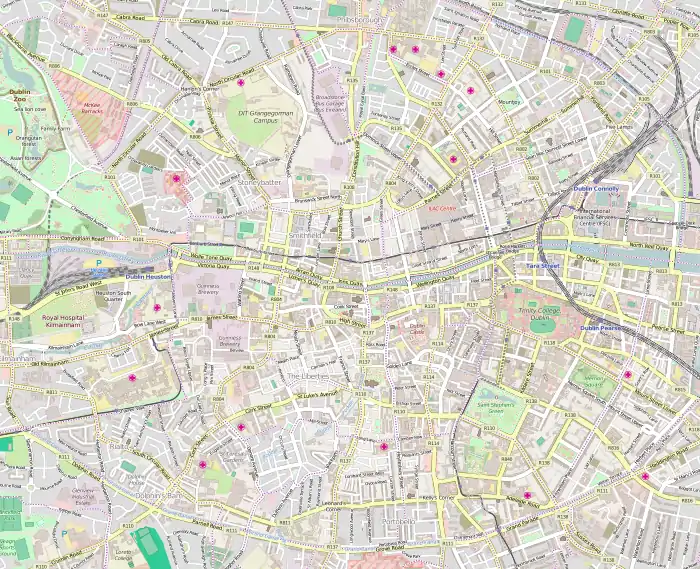Royal Hospital Kilmainham
The Royal Hospital Kilmainham (Irish: Ospidéal Ríochta Chill Mhaighneann) in Kilmainham, Dublin, is a former 17th-century hospital at Kilmainham in Ireland.
| Royal Hospital Kilmainham | |
|---|---|
 View of the northside of the main building | |

| |
 Shown in Dublin | |
| Geography | |
| Location | Kilmainham, Dublin, Ireland |
| Coordinates | 53.343303°N 6.300177°W |
| Organisation | |
| Type | Specialist |
| Services | |
| Speciality | Hospital for retired soldiers |
| History | |
| Opened | 1684 |
| Closed | 1927 |
History
A priory, founded in 1174 by Strongbow, existed on the site until the Crown closed it down in the Dissolution of the Monasteries in the 1530s.[1] The hospital was built as a home for retired soldiers, on the model of the Royal Hospital, Chelsea, of the Irish Army by Sir William Robinson, Surveyor General for James Butler, 1st Duke of Ormond, Lord Lieutenant of Ireland, between 1679 and 1687.[2] Architecturally, it was inspired by Les Invalides in Paris which also has a formal facade and a large courtyard.[3]
The Richmond Tower at the end of the formal avenue leading to the Royal Hospital was designed by Francis Johnston, one of the leading architects of the day.[4] This gateway originally stood beside the river Liffey at Bloody Bridge (now Rory O'More Bridge), but had to be moved after the arrival of the railway in 1844 increased traffic congestion. He had placed his personal coat of arms above the arch, concealed by a piece of wood painted to match the stone, his idea being that his arms would be revealed to future generations after the wood became rotten. However, his little trick was uncovered when the gateway was taken down for removal. The coat of arms at present on the gateway is that of the Royal Hospital.[5]
The Royal Hospital Kilmainham graveyards, including Bully's Acre, are 400 metres to the west. A cross-shaft in the former cemetery may be the remains of a boundary cross associated with a ninth-century monastery located at this site.[6]

Following the creation of the Irish Free State the Royal Hospital was considered as a potential home for Oireachtas Éireann, the new Irish national parliament. Eventually it was decided to keep parliament in its temporary home in Leinster House.[7] The Hospital remained the home of a dwindling number of soldiers until it closed in 1927.[3] It was then variously used by the Garda Síochána and as a storage location for property belonging to the National Museum of Ireland. The large statue Queen Victoria which used to stand in the forecourt of Leinster House, before its removal in 1947, was stored in the main courtyard of the Hospital,[8] as were various state carriages, including the famously spectacular State Coach of the Lord Chancellor of Ireland.[9] The Royal Hospital in Kilmainham was finally restored by the Irish Government in 1984 and opened as the Irish Museum of Modern Art (IMMA).[10]
Every year on the National Day of Commemoration – the Sunday nearest 11 July – the anniversary of the Truce that ended the Irish War of Independence – the President of Ireland, in the presence of members of the Government of Ireland, members of Dáil Éireann and of Seanad Éireann, the Council of State, the Defence Forces, the Judiciary and the Diplomatic Corps, lays a wreath in the courtyard in memory of all Irishmen and Irishwomen who have died in past wars and on service with the United Nations.[11]
In recent years, Royal Kilmainham Hospital has become a popular location for concerts during the summer months. Acts such as Blur, Damien Rice, Tame Impala, Kodaline and Patti Smith have played there in the past.[12]
See also
- Kilmainham Gaol
- Royal Hospital Chelsea (equivalent in London)
- Puyloubier (French Foreign Legion equivalent)
References
- Lennox Barrow, G. (1 June 1985). "The Knights Hospitaller of St. John of Jerusalem at Kilmainham". Dublin Historical Record. Dublin Historical Record. 38 (3): 108–112. JSTOR 30100662.
- "Sir William Robinson". Oxford Dictionary of National Biography. Retrieved 10 May 2019.
- "Royal Hospital Kilmainham". Heritage Ireland. Retrieved 10 May 2019.
- "Co. Dublin, Dublin, Circular Road South (Kilmainham), Royal Hospital". Dictionary of Irish Architects. Retrieved 10 May 2019.
- Guinness, Desmond; Jacqueline O'Brien (1994). Dublin: A Grand Tour. London: Weidenfeld & Nicolson. p. 38. ISBN 978-0-297-82221-9.
- Murphy, Sean (1989). Bully's Acre and Royal Hospital Kilmainham graveyards: history and inscriptions (PDF). Dublin: Divelina Publications. p. 5. ISBN 978-0-9512611-1-8.
- "A Parliament seeking a home". Oireachtas. 3 April 2019. Retrieved 10 May 2019.
- "Statues of Dublin: The unveiling (and removal) of Queen Victoria". Come here to me. 24 May 2012. Retrieved 10 May 2019.
- "The Lord Mayor's Coach". Dublin City. Retrieved 10 May 2019.
- "Twenty years of the Irish Museum of Modern Art". The Irish Times. 19 March 2011. Retrieved 10 May 2019.
- "Dublin ceremony remembers Irish war dead". Irish Times. 9 July 2006. Retrieved 10 May 2019.
- "Five times the Royal Hospital Kilmainham has hosted amazing gigs". Joe.ie. Retrieved 10 May 2019.